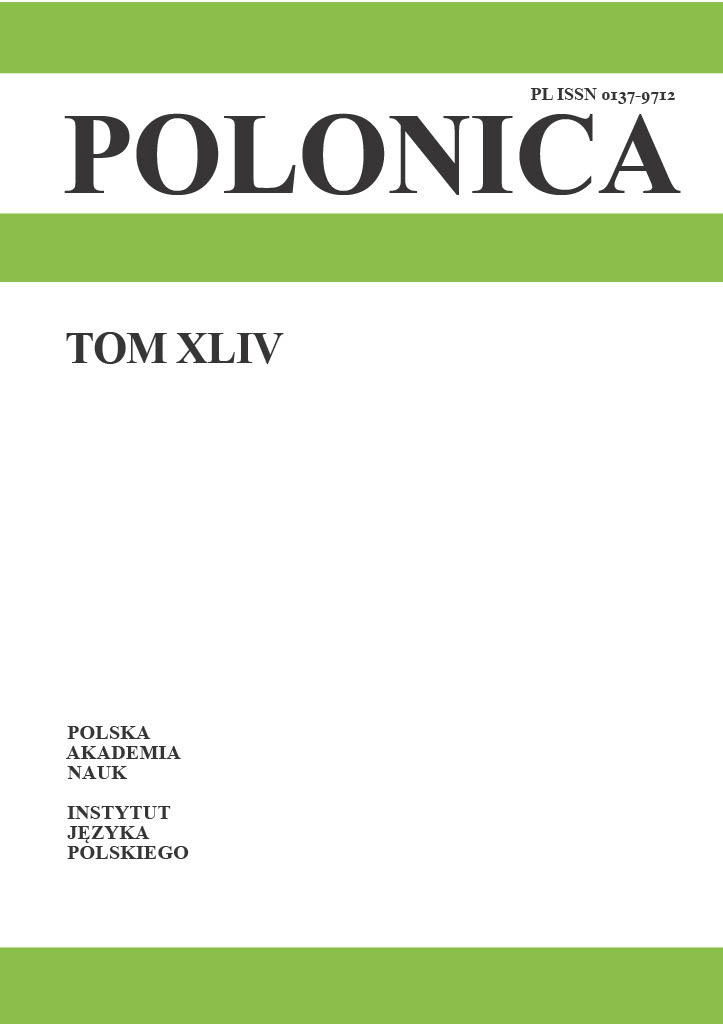Abstract
The article discusses the grammatical status of the ‘support particle’ że prefixed in colloquial Polish to the enclitic person markers of the past tense. It is argued that the use of this particle, identical with the complementizer że ‘that’, is not only phonologically but also grammatically motivated, even though it is true that attachment of bare person markers to certain hosts is blocked for phonological reasons. A crucial role in the process of its rise may have been played by the identification of person markers across moods, the enclitic person markers of the past tense being identified with the affixal person markers of the irrealis, which occurred only in conjunction with the irrealis marker and could only be moved together with it. It is hypothesized that this induced the rise of an enclitic conjoint realis plus person marker as a pendant to the conjoint irrealis plus person marker. Clausal complementation provided the source context for the introduction of że as a realis marker in addition to its original function as a complementizer.
References
Ammann, A., & van der Auwera, J. (2004). Complementizer-headed main clauses for volitional moods in the languages of South-Eastern Europe. A Balkanism? O. Mišeska Tomić (Ed.), Balkan Syntax and Semantics (pp. 293–314). Amsterdam/Philadelphia: John Benjamins.
Aronoff, M . (1993 ). Morphology by Itself. Stems and Inflectional Classes. Cambridge, MA: MIT Press.
Bajerowa, I. (1964). Kształtowanie się systemu polskiego języka literackiego w XVIII wieku. Wrocław: Ossolineum.
Bański, P. (2000). Morphological and Prosodic Analysis of Auxiliary Clitics in Polish and English. PhD dissertation. Warsaw: Warsaw University.
Borsley, R. D., & Rivero, M. R. (1994). Clitic auxiliaries and incorporation in Polish. Natural Language and Linguistic Theory, 12(3), 373–422.
Chafe, W. (1995). The realis-irrealis distinction in Caddo, the Northern Iroquoian languages, and English. In: J. L. Bybee, & S. Fleischman (Eds.), Modality in Grammar and Discourse (pp. 349–365). Amsterdam/Philadelphia: John Benjamins.
Długosz-Kurczabowa, K., & Dubisz, S. (2006). Gramatyka historyczna języka polskiego. Wyd. 3 poszerzone i zmienione. Warszawa: Wydawnictwa Uniwersytetu Warszawskiego.
Frajzyngier, Z. (1995). A functional theory of complementizers. J. L. Bybee & S. Fleischman (Eds.), Modality in Grammar and Discourse (pp. 473–502). Amsterdam/Philadelphia: John Benjamins.
Hopper, P. J., & Traugott, E.C. (2003). Grammaticalization. 2nd edition. Cambridge: Cambridge University Press.
Jagódzka, D. (2018). Auxiliary clitics in Polish. Linguistics Beyond And Within, 4, 63–78.
Kowalska, A. (1976). Ewolucja analitycznych form czasownikowych z imiesłowem na -ł w języku polskim. Katowice: Uniwersytet Śląski.
Leskien, A. (1919). Grammatik der altbulgarischen (altkirchenslavischen) Sprache. 2. u. 3. Auflage. Heidelberg: Carl Winter.
Lewaszkiewicz, T. (2023). Formy czasu przeszłego rodzaju nijakiego w 1. i 2. osobie liczby pojedynczej typu widziałom, widziałoś w językach słowiańskich. Rocznik Slawistyczny, 72, 117–142.
Migdalski, K. (2006). The Syntax of Compound Tenses in Slavic. PhD Dissertation, Tilburg University. Utrecht: LOT.
Palmer, F. R. (2001). Mood and Modality. 2nd edn. Cambridge: Cambridge University Press.
Pisarkowa, K. (1984). Historia składni języka polskiego. Wrocław etc.: Ossolineum.
Sampanis, K. (2012). The Modern Greek subjunctive mood and its semantic features. G. Fragaki, Th. Georgakopoulos, & Ch. Themistocleous (Eds.), Current Trends in Greek Linguistics (pp. 66–91). Newcastle: Cambridge Scholars Publishing.
Schenker, A. M. (1973). Beginning Polish. Vol. 1. New Haven/London: Yale University Press.
Stieber, Z. (1979). Zarys gramatyki porównawczej języków słowiańskich. Warszawa: Państwowe Wydawnictwo Naukowe.
Witkoś, J. (1997). On the syntactic status of że/that and its implications for the theory of phrase structure in Polish. R. Hickey, & St. Puppel (Eds.), Language History and Linguistic Modelling. A Festschrift for Jacek Fisiak on His 60th Birthday (pp. 1555–1582). Berlin/New York: Mouton De Gruyter.

This work is licensed under a Creative Commons Attribution-NoDerivatives 4.0 International License.
Copyright (c) 2024 Instytut Języka Polskiego PAN

